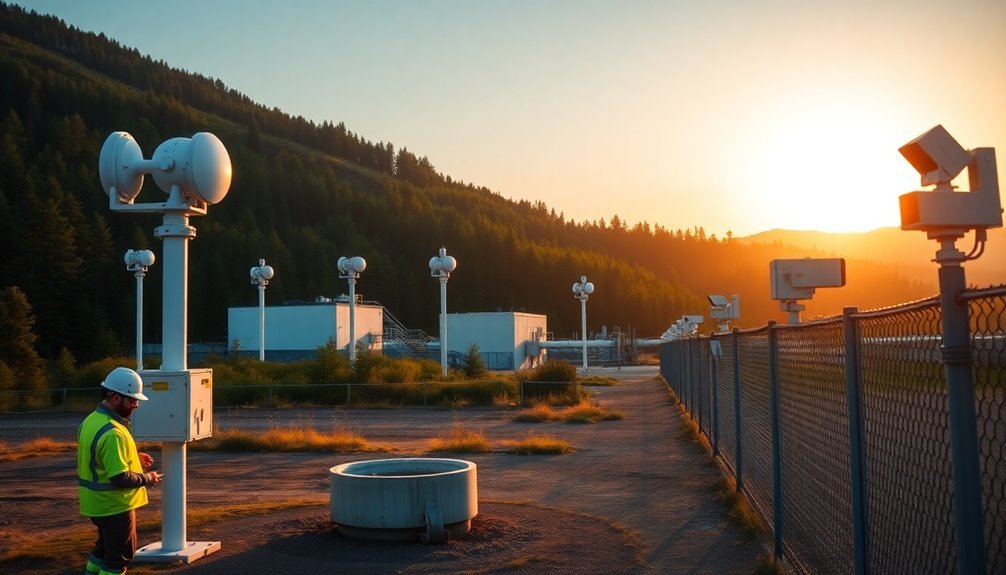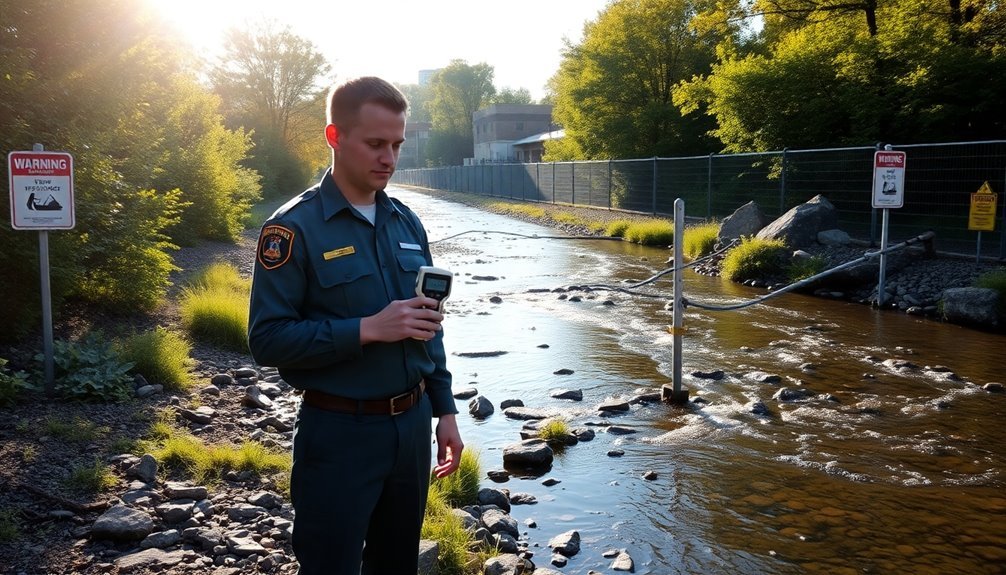You'll need to follow these five essential rules for environmental monitoring at protected facilities: conduct thorough risk assessments using HACCP and FMEA tools, implement properly calibrated monitoring equipment that meets NIST standards, guarantee your environmental inspectors complete certified training programs, establish standardized data collection protocols with cloud-based storage, and follow IUCN-WCPA framework guidelines for protected area management. Each rule plays a vital role in safeguarding human health, protecting the environment, and maintaining regulatory compliance. Understanding these fundamentals will open the door to more advanced monitoring strategies and sustainable facility management.
Risk Assessment and Site Selection

Why do protected facilities require rigorous environmental monitoring? Protected facilities need thorough monitoring to safeguard human health, protect the environment, and guarantee regulatory compliance.
You'll need to start with a detailed risk assessment that integrates your facility's processes, equipment, and product knowledge.
Begin by identifying and analyzing all potential risks using HACCP and FME(C)A tools. You'll want to categorize these risks as high, medium, or low based on their impact and likelihood.
When selecting monitoring sites, evaluate the exposure potential and consider factors like distance from treated fields, prevailing winds, and runoff risks. Don't forget to prioritize areas with sensitive species or habitats.
Your site selection should focus on locations where there's the highest potential for human or environmental exposure to contaminants. You'll need to assess the soil type, slope, and any natural barriers that might affect contamination spread.
Remember to review your Environmental Monitoring Risk Analysis regularly to maintain process control and incorporate new information. This approach guarantees you're focusing resources on the areas that present the greatest risk while maintaining adequate coverage of moderate-risk zones.
Monitoring Equipment and Compliance Standards
A robust monitoring system requires carefully calibrated equipment and strict compliance with international standards. You'll need to follow recognized standards like NIST for calibration and regularly compare your measuring equipment to reliable standards to guarantee accuracy. Document all adjustments and maintain detailed records for compliance audits. Limiting access to authorized personnel only helps maintain equipment integrity and prevents unauthorized adjustments.
You must implement both continuous emission monitoring systems (CEMS) and predictive emission monitoring systems (PEMS) to track pollutants effectively. These systems will help you monitor CO2, NOx, and particulate matter concentrations while meeting ISO 14001 requirements. Use environmental management software to automate calibration schedules and centralize your monitoring control.
Your compliance monitoring should include both on-site and off-site activities. Conduct regular inspections, evaluations, and investigations while collecting and reviewing data to support compliance.
You'll need to carry out Full Compliance Evaluations (FCE) or Partial Compliance Evaluations (PCE) to meet Clean Air Act requirements. Train your inspectors thoroughly and guarantee they can perform efficient compliance monitoring.
Remember to continuously review and adapt your monitoring practices to address new environmental challenges as they emerge.
Training for Environmental Inspectors

Training for successful environmental inspectors starts with thorough certification programs and ongoing professional development. You'll need to complete foundational programs like CalEPA's Basic Inspector Academy or OSU's Environmental Compliance Training to learn essential inspection techniques and regulatory requirements.
You'll want to pursue certifications that match your career goals. The CWEA Environmental Compliance Inspector Certification offers enhanced standards and career flexibility, while the ABCEP Certified Environmental Professional demonstrates high-level expertise. A comprehensive Environmental Management Certificate program including 11 professional development seminars can prepare you for multiple certification exams. You'll need to master compliance regulations, including RCRA and EPA 40 CFR standards, along with viable sampling techniques and monitoring requirements.
Cross-training is vital for conducting quality inspections across different environmental media. You'll benefit from programs like the OSHA Safety Certificate and Certified Stormwater Manager certification to expand your expertise.
To maintain your professional edge, you'll need to commit to continuing education that keeps you current with changing regulations and industry advancements.
Your certification efforts will pay off through increased job security, higher compensation, and enhanced professional credibility. Your employer will also benefit from your expertise through improved public confidence and reduced liability risks.
Data Collection and Analysis Protocols
Following standardized protocols, you'll need to establish robust data collection and analysis procedures for protected facilities. Start by implementing DEP-approved methods while incorporating remote sensing and in-situ sensors for thorough monitoring. Environmental data should be collected through intensive field stations that combine multiple measurement techniques.
You'll want to conduct regular field surveys to supplement automated data collection and maintain strict quality assurance measures.
When selecting monitoring sites, you must prioritize high-risk locations and environmentally sensitive areas. Consider geographical factors like slope and soil type, while ensuring you're maintaining appropriate distances from critical habitats and pollinator zones.
Don't forget to verify that your site selections comply with current regulatory standards.
You'll need to leverage advanced analytics tools and mobile applications for efficient data processing and real-time decision-making. Implement composite sampling methods to create representative datasets, and conduct regular statistical analyses to interpret your findings.
To streamline your monitoring efforts, integrate IoT devices and automated systems for continuous data collection. Make sure you're using appropriate sensing technologies, including air quality sensors and filtration methods like impingers.
Store your data using cloud-based solutions to improve accessibility and facilitate collaboration among team members.
Protected Area Management Systems

Building on your data collection framework, protected area management systems require a thorough approach guided by the IUCN-WCPA framework.
You'll need to focus on design issues, management systems adequacy, and delivery of objectives while implementing extensive evaluation indicators across six key elements.
When you're designing your protected area management strategy, consider vital factors like size, shape, edge effects, and proximity to human activities. The growing complexity of managing diverse ecosystems requires integrated solution approaches to address multifaceted challenges effectively.
You'll want to integrate technological tools such as SMART and ArcGIS Conservation Solutions to enhance your monitoring capabilities. These digital systems will help you collect data more efficiently and make better-informed decisions about resource allocation.
To maximize effectiveness, you should adopt an adaptive management approach that's both responsive and proactive.
You'll find that properly managed areas not only conserve biodiversity but also generate economic benefits through activities like ecotourism.
Make sure you're consistently evaluating performance using SMART-based ranger assessments and maintaining a holistic understanding of your protected area's context, including its values, threats, opportunities, and stakeholders.
This extensive approach will help you achieve both conservation goals and management objectives effectively.
Frequently Asked Questions
How Often Should Environmental Monitoring Equipment Be Calibrated and Maintained?
You'll need to calibrate your environmental monitoring equipment annually at minimum, but you should follow manufacturer's recommendations and adjust frequency based on usage, environmental conditions, and regulatory requirements for your specific instruments.
What Are the Legal Implications of Failing to Report Environmental Violations?
You'll face hefty fines, potential criminal charges, and loss of regulatory benefits if you don't report violations. You're also risking public health consequences and more severe penalties beyond those for the original violation.
Can Local Communities Participate in Protected Area Monitoring Programs?
Yes, you can definitely participate in protected area monitoring. You'll strengthen conservation efforts through local knowledge, joint patrols, threat identification, and information sharing. Many programs actively welcome community involvement in their monitoring activities.
How Do Seasonal Changes Affect Environmental Monitoring Schedules and Procedures?
You'll need to adjust your monitoring schedules based on seasonal temperature, humidity, and light changes. You should increase frequency during extreme weather periods and modify equipment calibration to match seasonal environmental conditions.
What Alternative Funding Sources Are Available for Environmental Monitoring Programs?
You can access EPA grants, private foundation funding, government programs, and community partnerships. Don't forget to explore proponent funding and internal resources while building sustainable partnerships for your environmental monitoring initiatives.
In Summary
You'll find that implementing these five environmental monitoring rules greatly strengthens your protected facility's oversight capabilities. Whether you're managing sensitive ecosystems or high-security installations, your success depends on thorough risk assessments, reliable monitoring equipment, well-trained inspectors, robust data protocols, and efficient management systems. By following these guidelines, you're better positioned to safeguard both the environment and your facility's integrity.





Leave a Reply